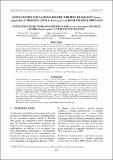Por favor, use este identificador para citar o enlazar este ítem:
https://hdl.handle.net/20.500.12958/3649| Título : | Indicadores poblacionales del tiburón diamante Isurus oxyrinchus y tiburón azul Prionace glauca en el litoral peruano |
| Otros títulos : | Population indicators of shortfin mako Isurus oxyrinchus and blue shark Prionace glauca in the Peruvian coast |
| Autor : | Pérez-Huaripata, Miguel Argumedo Guillén, Edgar Tacuri Santisteban, Paul Lau Medrano, Wencheng Castillo Mendoza, Gladis Saldarriaga Mendoza, Maritza Palacios León, Jacqueline Guevara Carrasco, Renato |
| Palabras clave : | Isurus oxyrinchus;Tiburón diamante;Prionace glauca;Tiburón azul;Pesquería;Indicadores poblaciones |
| Fecha de publicación : | dic-2021 |
| Editorial : | Instituto del Mar del Perú |
| Citación : | Pérez-Huaripata M, Argumedo E, Tacuri P, Lau W, Castillo G, Saldarriaga M, Palacios J, Guevara-Carrasco R. 2021. Indicadores poblacionales del tiburón diamante Isurus oxyrinchus y tiburón azul Prionace glauca en el litoral peruano. Inf Inst Mar Perú. 48(4): 578-593 |
| Citación : | Informe IMARPE 48(4), 2021; |
| Resumen : | Se determinaron algunos indicadores poblacionales de tiburón diamante (Isurus oxyrinchus) y tiburón azul (Prionace glauca) con información biológico-pesquera recolectada a lo largo del litoral peruano en el periodo 1996-2018. Los mayores desembarques de estas especies se registraron en la zona sur con el arte de pesca espinel, siendo el tiburón azul la especie predominante. A partir de la distribución de frecuencia de tallas, se determinó que el 70% de ejemplares de tiburón azul capturados en la zona norte-centro están sobre la TMC (>160 cm de LT) en tanto para el tiburón diamante se registró un menor porcentaje de ejemplares con tallas sobre la TMC (>170 cm de LT) en ambas zonas. Las series de CPUE mostraron tendencia negativa, observando una caída más pronunciada en el caso del tiburón diamante. La herramienta FishPath dio un listado de opciones de manejo, siendo las más recomendables limitar el esfuerzo y establecer vedas temporales, a fin de reducir la presión pesquera
ejercida sobre ambas especies de tiburones. ABSTRACT: Information from artisanal landings in the Peruvian coast between 1996 and 2018 was used to determine the population indicators of the shortfin mako (Isurus oxyrinchus) and blue shark (Prionace glauca). Their highest landings occurred in southern Peru and the longline was the most used fishing gear for both species. The blue shark was the predominant species and 70% of specimens caught in north-central Peru were larger than the minimum catch size (>160 cm TL). Conversely, only 7% of the shortfin mako specimens sampled in this area and 4% in the southern zone were larger than the minimum catch size (>170 cm TL). Finally, the FishPath tool suggested a list of management options, of which the most advisable are effort limitation and time closures to reduce fishing pressure on both shark species. |
| URI : | https://hdl.handle.net/20.500.12958/3649 |
| ISSN : | 0378-7702 |
| Aparece en las colecciones: | Informe vol. 48(4) 2021 |
Ficheros en este ítem:
| Fichero | Descripción | Tamaño | Formato | |
|---|---|---|---|---|
| Informe 48-4 articulo7.pdf | 8,26 MB | Adobe PDF |  Visualizar/Abrir |
Este ítem está sujeto a una licencia Creative Commons Licencia Creative Commons

